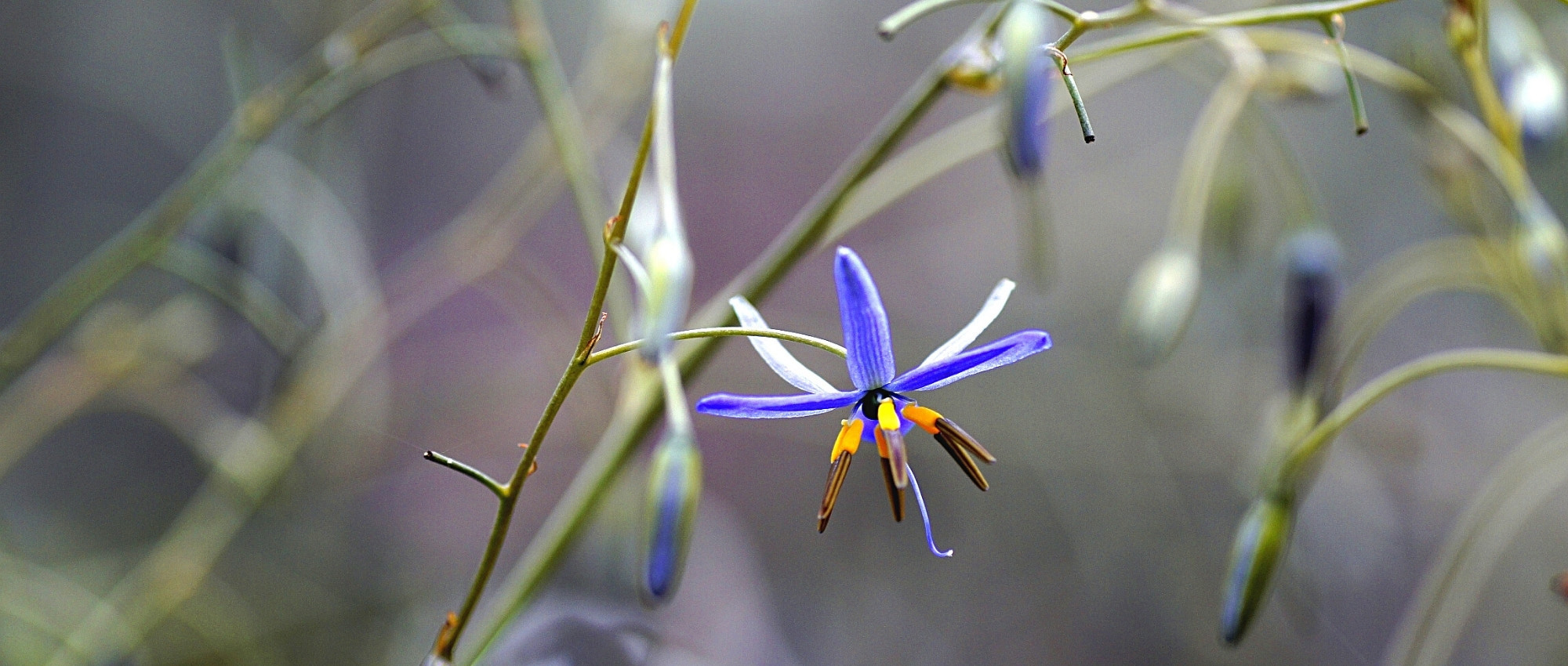
Dianella: planting, cultivation and maintenance
Contents
Dianella in a nutshell
- Dianella are decorative perennial rhizomes with their foliage, flowers, and blue berries
- They display light panicles of small blue flowers with yellow stamens in early summer
- They form clumps of long upright leaves, resembling Phormiums
- Their highly graphic foliage takes on different shades depending on the varieties: green, blue-grey, chocolate brown, or variegated with white
- They are particularly suited to seaside gardens and can be grown in pots in cooler regions
A word from our expert
Dianella are rhizomatous perennials mainly native to Australia, forming clumps of long, narrow leaves reminiscent of Phormium foliage. The leaves come in various shades depending on the varieties: they can be green, blue-tinged, chocolate brown, or variegated with white. Dianella is also very decorative due to its flowering in light, airy panicles, bearing numerous small star-shaped blue flowers, with yellow stamens. These flowers then give way to stunning metallic blue berries. Dianella is one of the few perennials that produce very decorative berries.
Dianella are not very hardy: they tolerate temperatures between -5 and -8 °C, and even down to -12 °C in a sheltered position and in perfectly drained soil. They can be planted in the ground in the Mediterranean basin and Atlantic coastal regions, where the risk of frost is low, but in the northern half of France, it is better to grow them in pots so they can be brought indoors for the winter. They are particularly suited to seaside gardens as they tolerate salt spray well. In the garden, they will easily find their place in a Mediterranean, exotic, or graphic style garden. Discover in this guide all our tips for successfully cultivating them, whether in the ground or in pots!
Botany
Botanical data
- Latin name Dianella sp.
- Family Xanthorrhoeaceae
- Common name Tasmanian lily
- Flowering between May-June and August, depending on the varieties
- Height between 40 and 80 cm
- Exposure non-burning sun or partial shade
- Soil type fertile, non-calcareous, perfectly drained
- Hardiness between -5 and -8 °C
Dianella are rhizomatous perennials that encompass around forty species, about half of which are native to Australia. The others come from New Zealand, eastern Africa, Madagascar, Southeast Asia, and the Pacific Islands. They primarily grow in understorey, as well as in scrub and heathland. The most commonly cultivated are Dianella revoluta and Dianella tasmanica, native to Australia and Tasmania. There are also many varieties, interesting for their foliage that takes on different hues.
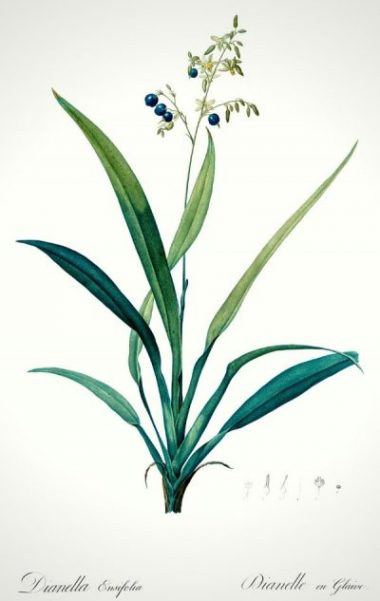 Dianella ensifolia: Botanical illustration
Dianella ensifolia: Botanical illustrationDianella belongs to the botanical family Xanthorrhoeaceae. This family includes ornamental plants with a very exotic style, such as Kniphofias, Hemerocallis, Eremurus, Aloes, Phormiums, Asphodels, Bulbines, and Haworthia.
Dianella was named in reference to the Roman goddess Diana. The suffix ella means “little”. The species name of Dianella tasmanica denotes its geographical origin: Tasmania. As for Dianella caerulea, its species name means “blue”, alluding to the flowers and berries.
Dianella forms clumps of wide, slender leaves, resembling the leaves of Irises. They reach between 40 and 80 cm high, and can even grow up to 1.20 m. The smaller varieties create a very beautiful effect when planted en masse. Dianella has an underground rhizome, allowing the clumps to gradually expand.
 The flowering of Dianella (photos: Adobe Stock / David Francis 34 / Louise Docker)
The flowering of Dianella (photos: Adobe Stock / David Francis 34 / Louise Docker)Dianella flowers in late spring or summer, between May-June and August depending on the species. They then display loose and very airy panicles, branched, measuring 40 to 60 cm long. They bear small star-shaped blue flowers with yellow stamens. The flowers measure 1 to 2 cm in diameter and consist of three petals and three blue sepals, all having the same appearance (this is referred to as tepals). They bear six yellow stamens in the centre, which are also very decorative, along with a central pistil. The blue petals are curved backward from the flower, in the opposite direction to the stamens. The delicacy and lightness of the flowers create a beautiful contrast with the massive, stiff, and linear appearance of the foliage. The flowers of Dianella are pollinated by insects, which transport the pollen from the stamens to the pistil of the flowers, allowing the plant to reproduce.
Dianella has very graphic foliage. It consists of long, upright ribbon-like leaves that resemble the leaves of Phormiums. The leaves are wide and stiff, with a rough edge to the lamina. They measure between 50 cm and 1.20 m long and have a well-defined central vein, parallel to the edge of the lamina. Depending on the varieties, the leaves can be stiff and well-erect (as in Dianella ‘Little Rev’) or very flexible and arching, as in Dianella ‘Emerald Arch’ or ‘Blaze’. The leaves are evergreen, ensuring a presence in the garden all year round, even in winter.
 The foliage of Dianella ‘Breeze’, Dianella tasmanica var. variegata and Dianella tasmanica (photos: Jason Baker / David J. Stang / Daderot)
The foliage of Dianella ‘Breeze’, Dianella tasmanica var. variegata and Dianella tasmanica (photos: Jason Baker / David J. Stang / Daderot)The leaves of Dianella come in a wide range of shades depending on the varieties. For instance, Dianella tasmanica ‘Variegata’ features beautiful variegated foliage with white, very bright. In contrast, Dianella tasmanica ‘Blaze’ offers very dark, chocolate-brown foliage. Dianella ‘Cassa Blue’ has beautiful bluish foliage, while the leaves of Dianella ‘Tas Red’ are bicoloured: red at the base and green on the rest of the lamina. Dianella tasmanica ‘Rainbow’ is one of the most colourful: the leaves are green variegated with cream-yellow, and tinged with red at the base. ‘Rainbow Twist’ has bluish-grey leaves edged in pink-red, with a changing hue throughout the seasons.
Dianella is among the few perennials with decorative berries. In autumn, the flowers give way to ovoid dark blue to purple berries, shiny, measuring 1 to 1.5 cm in diameter. They contain black seeds, which can be collected to propagate the plant by sowing.
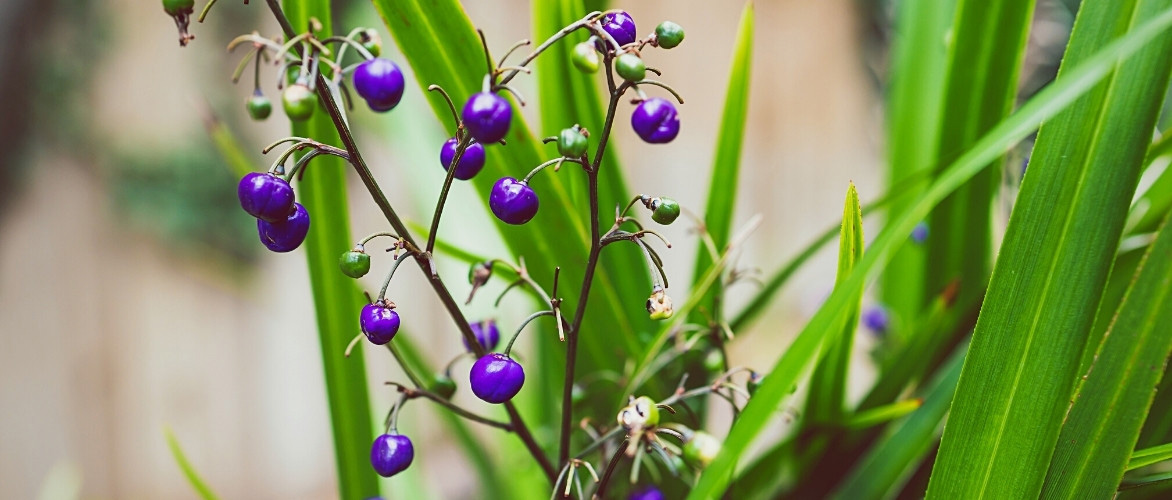 The blue-purple berries of Dianella (photo: Adobe Stock)
The blue-purple berries of Dianella (photo: Adobe Stock)The main varieties of Dianella
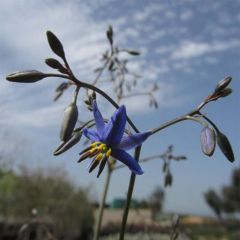
Dianella revoluta Little Rev
- Flowering time July to September
- Height at maturity 40 cm
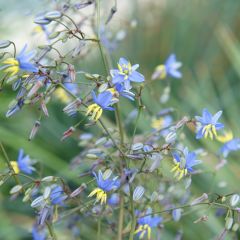
Dianella revoluta Coolvista
- Flowering time July to September
- Height at maturity 60 cm
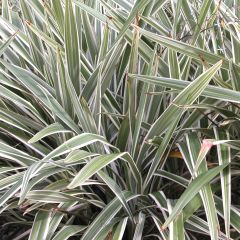
Dianella tasmanica Variegata
- Flowering time June, July
- Height at maturity 80 cm
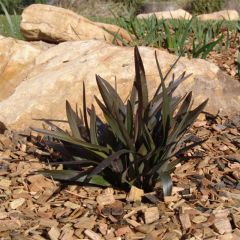
Dianella tasmanica Blaze
- Flowering time June to August
- Height at maturity 45 cm
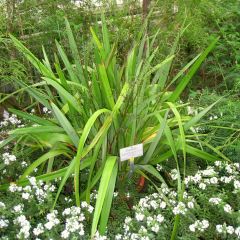
Dianella tasmanica
- Flowering time June, July
- Height at maturity 80 cm
Discover other Dianella
View all →Available in 1 sizes
Available in 1 sizes
Available in 2 sizes
Available in 1 sizes
Available in 1 sizes
Available in 2 sizes
Available in 1 sizes
Young plantation
Where to plant?
In the warm regions of southern France, particularly in the Mediterranean basin, we advise you to install Dianella in shade or partial shade. In Australia, in its natural environment, it generally grows in undergrowth and therefore appreciates shaded locations. The scorching sun could damage its foliage. However, in the northern half of France, where temperatures are cooler, we advise you to place it in the sun as it needs warmth. In any case, choose a location sheltered from cold winds. Dianella is not a very hardy plant (it seems to withstand temperatures down to -12 °C in a sheltered situation and in well-draining soil): outside the Atlantic coast and the Mediterranean basin, it will need to be protected in winter: either by wrapping it in a winter cover and placing a thick layer of mulch around the clump, or by growing it in a pot and bringing it indoors for the winter.
Dianella are particularly suited to seaside gardens, as they tolerate sea spray well.
As for the nature of the soil, the most important thing is to grow Dianella in perfectly drained soil, as stagnant moisture could cause its roots to rot. If your soil tends to retain water, do not hesitate to improve drainage by mixing gravel or coarse sand into the planting soil. You can also plant it on a mound so that water drains away quickly. Dianella also appreciates fertile soils rich in humus. Do not hesitate to add some well-decomposed compost at the time of planting. Finally, it does not like calcareous soils: it needs a neutral or acidic substrate.
Dianella will easily integrate into a Mediterranean or exotic style garden. Varieties with brown foliage (like Dianella ‘Blaze’) or variegated (Dianella tasmanica ‘Variegata’) are perfect in a graphic style garden. Dianella can be planted in a raised rockery, which will allow for ideal drainage, and will also create a very beautiful effect if planted along a path. Larger varieties can be planted alone or in small groups, for example in front of the house entrance or at the edge of a lawn to highlight their massive foliage, while smaller varieties, like Dianella ‘Little Rev’, will create a more beautiful effect when planted en masse.
When to plant?
Plant Dianella in spring, in April or May, as soon as there is no longer a risk of frost.
How to plant?
In open ground:
- Dug a planting hole, about twice the size of the root ball.
- Replace it with soil mixed with some well-decomposed compost and add gravel or coarse sand if needed to improve drainage.
- Remove Dianella from its pot and place it in the planting hole.
- Replace soil all around.
- Water generously.
- We advise you to install an organic mulch around the clump. This will help maintain soil freshness longer and thus reduce watering, while limiting the growth of weeds.
In pot:
- Choose a pot with drainage holes.
- Place a layer of gravel or clay balls at the bottom.
- Then place a well-draining and non-calcareous substrate in it. For example, make a mixture with potting soil, garden soil, coarse sand, and possibly a bit of heather soil.
- Remove Dianella from its original pot and place it in the new one, right in the centre.
- Add a bit of potting soil all around the root ball.
- Water generously.
Place the pot in the sun or partial shade, sheltered from cold winds.
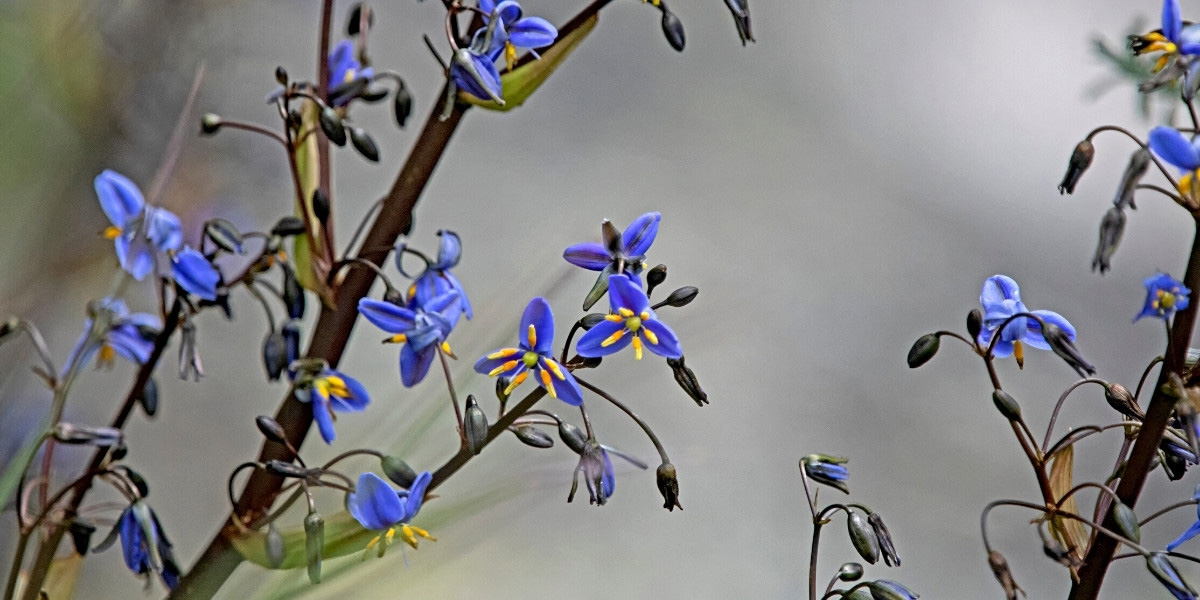 Dianella tasmanica
Dianella tasmanicaMaintenance
In open ground
Carry out regular watering in the weeks following planting to help the plant settle in and develop its root system. If your water is hard, water if possible with rainwater. Once established, Dianella tolerates summer drought well and can do without watering. However, you may want to apply a layer of mulch around the clump to keep the soil cool for longer.
Feel free to protect Dianella from the cold in winter by wrapping it in a winter fleece and placing a thick layer of mulch around the clump.
Do not cut off the faded flower spikes, otherwise your Dianella will not be able to produce berries! The flowers, after being pollinated, can give way to stunning metallic blue berries.
Dianella is not particularly susceptible to diseases and pests.
In pots
In cooler regions, grow Dianella in pots and bring it under cover in autumn. Place it in a bright but not too warm location, such as in a conservatory or a cold greenhouse kept frost-free. You can take it outside again in the following spring, as soon as there is no longer a risk of frost.
If you are growing Dianella in a pot, remember to water it regularly (once or twice a week) in spring and summer. You can reduce watering in autumn and winter. Preferably use rainwater. Do not let water stagnate in the saucer. We also recommend adding some fertiliser to support growth and flowering. For example, use a liquid fertiliser, which you will dilute in the watering water.
Multiplication
Sowing
To carry out the sowing, you can pick the blue berries when they are fully ripe and then collect the seeds they contain. Germination seems to be facilitated by soaking the seeds in water for 24 hours.
- Prepare pots by filling them with special sowing compost.
- Lightly compact and level the surface of the compost.
- Sow the seeds.
- Cover with a thin layer of compost.
- Water gently.
- All you need to do is place the pots in a sheltered spot that is bright but not in direct sunlight, ideally at a temperature between 13 and 16 °C. Temperatures above 18 °C may prevent germination.
Make sure to keep the substrate slightly moist until germination, which usually occurs after about 2 weeks, but may sometimes take longer. You can repot the seedlings into individual pots as soon as they reach a size that allows for handling. Wait until the following spring before planting them in the garden.
Tuft Division
Dianella is a rhizomatous perennial, so it can be easily divided. Compared to sowing, division will allow you to obtain new plants ready to be planted in the garden more quickly and simply. We recommend doing this in spring.
- Choose a healthy, well-developed tuft of Dianella, then carefully dig it up by excavating all around.
- If necessary, remove excess soil to make the roots and rootstocks visible.
- Separate the tuft into several sections by cutting the rootstocks. Ensure that each fragment retains roots.
- Replant in a new location after preparing the ground, or in a pot.
- Water generously.
Association
As it is particularly suited to the mild coastal climates, you can incorporate Dianella into a Mediterranean-style garden. It will be perfect at the foot of the majestic silhouette of an olive tree, with dark-leaved varieties like Dianella ‘Blaze’ creating a stunning contrast with its silvery grey foliage. Also consider cistus, strawberry trees, figs, palms, and oleanders! Incorporate herbs such as lavenders, thymes, rosemaries, santolines, and helichrysums. Bring colour with the flowering of Phlomis fruticosa, agapanthus, Delosperma, and helianthemums.
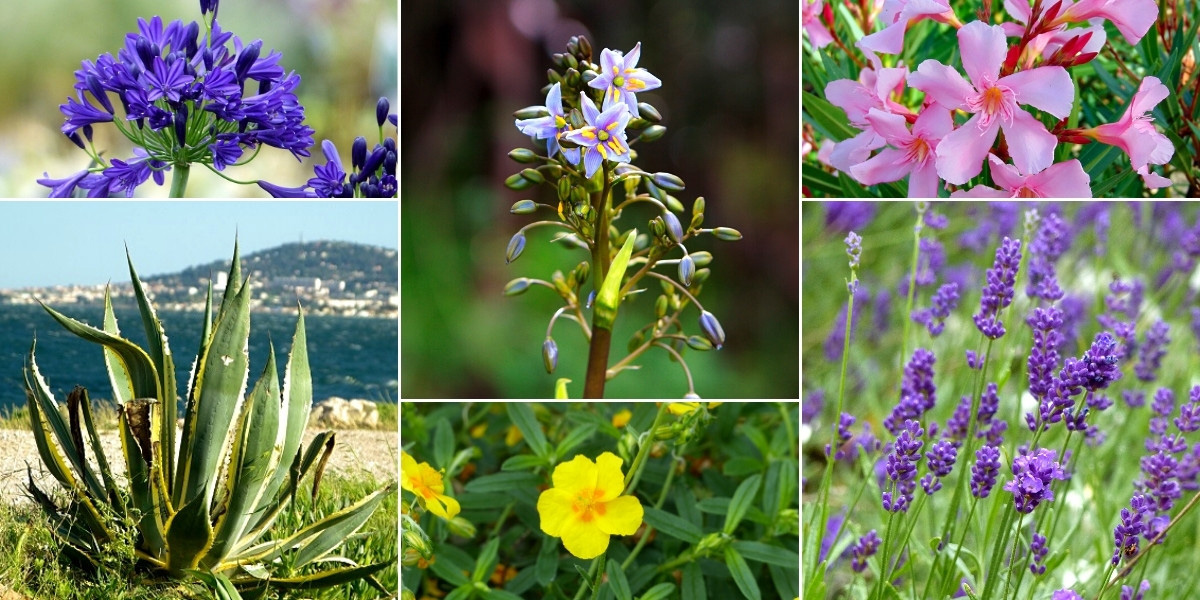
Dianella easily integrates into a Mediterranean-style garden. Here, Agapanthus ‘Royal Velvet’, Dianella tasmanica (photo Adobe Stock), Nerium oleander ‘Emilie’, Agave americana ‘Variegata’, Helianthemum ‘Ben Fhada’, and Lavandula angustifolia ‘Hidcote’
Native to the Southern Hemisphere, particularly Australia, Dianella will naturally find its place in an exotic garden. Feel free to pair it with southern hemisphere plants! Consider, for example, the graphic foliage of Phormiums, Cordyline australis, and Carex comans ‘Bronze Form’. These foliage types will create a stunning frame to highlight the flowering of Dietes bicolor, kniphofias, crocosmias, eucomis, and the very original Anigozanthos. Also discover Tigridia pavonia, known as Peacock Eye, a lovely bulb that produces white, yellow, or red flowers in summer, with a triangular corolla and a purple-striped throat.
Discover our inspiration page “Australian Exoticism”
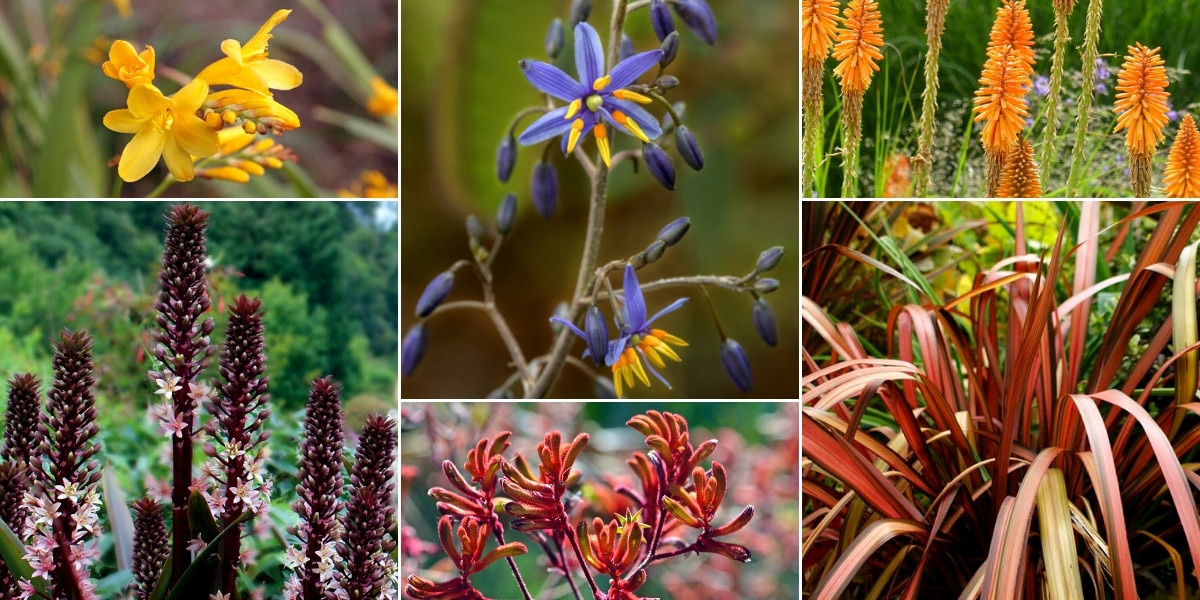
Dianella allows for the creation of a beautiful “Australian Exoticism” atmosphere in the garden. Crocosmia ‘Sunglow’, Dianella longifolia (photo Adobe Stock), Kniphofia ‘Fiery Fred’, Eucomis ‘Sparkling Rosy’, Anigozanthos, and Phormium ‘Pink Panther’
The Dianella tasmanica ‘Blaze’ and ‘Variegata’, with their chocolate brown or variegated white foliage, are perfect in a graphic and contemporary garden. Create a garden with clean shapes, with sharp and well-defined borders, Japanese stepping stones, and trimmed bushes (boxwood, Ilex crenata, Lonicera nitida…). We recommend favouring subtle and elegant shades rather than bright colours: opt for white, purple, black, and bronze… Enjoy the very graphic flowering of Allium schubertii, Echinops ‘Star Frost’, and agapanthus ‘Black Magic’ or ‘Glacier Stream’. You can also integrate some grasses, such as Pennisetums or Stipas: their fine foliage and light spikes will bring a lovely contrast.
You can also associate Dianella with other perennials and decorative fruit shrubs. Consider, for example, callicarpa, symphorines, euonymus, viburnums, Liriope muscari, and Maianthemum bifolium.
Useful resources
- Discover our range of Dianella
- To pair Dianella in the garden, check out our inspiration page “Australian Exoticism”
- Dianella also pairs very well with Mediterranean perennials
- Learn more about perennials with decorative fruits
- Subscribe!
- Contents



































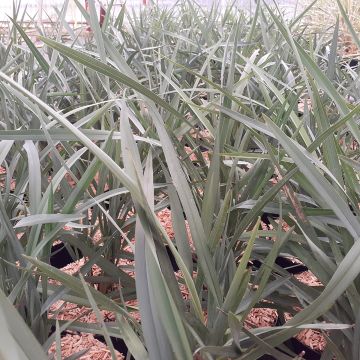


Comments